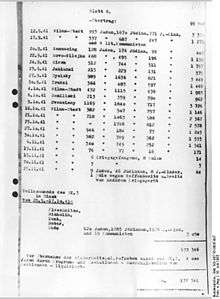''Einsatzgruppen'' reports
The Einsatzgruppen Operational Situation Reports (OSR's), or ERM for the German: Die Ereignismeldung UdSSR, were dispatches of the Nazi death squads, which documented the progress of the Holocaust behind the German-Soviet frontier, in the course of Operation Barbarossa during World War II. The extant reports were sent between June 1941 and April 1942 to the Chief of the Security Police and the SD (German: Chef des Sicherheitspolizei und SD) in Berlin from the occupied eastern territories including modern-day Poland, Belarus, Ukraine, Russia, Moldova, and the Baltic Countries. During the Nuremberg War Crimes Trials the originals were grouped according to year and month and catalogued using a consecutive numbering system, listed in the following table. At present, the documents are held at the National Archives in Washington D.C..[1][2]
The reports were grouped and numbered by the Allies according to their content. The original German cables (Ereignismeldung) were sent in their own order by Einsatzgruppe A attached to Army Group North, Einsatzgruppe B attached to Army Group Center, Einsatzgruppe C attached to the Army Group South, and Einsatzgruppe D attached to the 11th Army. Notably, in Operational Situation Report number 19, Einsatzgruppe C was changed to Einsatzgruppe B and vice versa, thus confusing further reports of their shooting actions.[3]
The OSRs are far from being equal. Some of them, such as OSR 156, include translated cables from several cities and weeks of shooting actions not yet concluded with tens of thousands of victims mentioned;[4] while other Operational Situation Reports, such as OSR 67, resemble long essays describing mere investigations into partisan activities in rural countryside resulting in dozens of executions.[5] Notably, the reports do not include all killings before the end of 1942.[6]
| Operational Situation Report (OSR): [Shootings] |
|---|
|
See also
- Einsatzgruppen
- Einsatzkommando
- Gerstein Report
- Höfle Telegram
- Jäger Report
- Katzmann Report
- Korherr Report
- Riegner Telegram
- Special Prosecution Book-Poland
Notes
- 1 2 Holocaust Education & Archive Research Team. "Index". Einsatzgruppen Operational Situation Reports. HolocaustResearchProject.org.
- ↑ Yitzhak Arad, with Shmuel Krakowski and Shmuel Spector (1989), The Einsatzgruppen reports: selections from the dispatches of the Nazi Death Squads’ campaign against the Jews July 1941-January 1943, New York, N.Y.: Holocaust Library. Edition details.
- ↑ Yitzhak Arad (2009). The Holocaust in the Soviet Union. Google Book. University of Nebraska Press. p. 126. ISBN 080322270X. Retrieved 25 March 2015.
- ↑ H.E.A.R.T (2008). "Einsatzgruppen Operational Situation Reports #156". Translated by Hermann Feuer. HolocaustResearchProject.org.
- ↑ H.E.A.R.T (2008). "Einsatzgruppen Operational Situation Reports #67". Translated by Hermann Feuer. HolocaustResearchProject.org.
- ↑ Ronald Headland (1992). Messages of Murder: A Study of the Reports of the Einsatzgruppen of the Security Police and the Security Service, 1941-1943. Tables of Killing Statistics: Einsatzgruppe A, B, C, and D. Fairleigh Dickinson Univ Press. pp. 98–101. ISBN 0838634184.
- ↑ Ken Lewis (December 30, 1997). "Summary of Operational Situation Reports: Shootings". Table of Contents : Einsatzgruppe A, B, C and D. The Einsatzgruppen Archives.com. Archived from the original on December 6, 2003 – via Internet Archive.
References
- Headland, Ronald (1992). Messages of murder: a study of the reports of the Security Police and the Security Service. Associated University Presses. ISBN 0-8386-3418-4.
